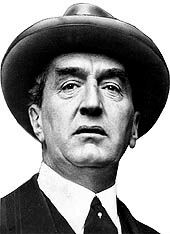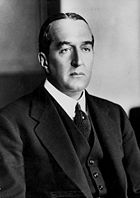Stanley Bruce
 |
|
|
8th Prime Minister of Australia
Elections: 1925, 1928, 1929 |
|
|---|---|
| In office 9 February 1923 – 22 October 1929 |
|
| Preceded by | Billy Hughes |
| Succeeded by | James Scullin |
| Constituency | Flinders (Victoria) |
|
|
|
| Born | 15 April 1883 Melbourne, Victoria, Australia |
| Died | 25 August 1967 (aged 84) London, England, UK |
| Political party | Nationalist |
Stanley Melbourne Bruce, 1st Viscount Bruce of Melbourne, CH, MC, FRS, PC (15 April 1883–25 August 1967) was an Australian politician and diplomat, and the eighth Prime Minister of Australia. He was only the second Australian ever granted an hereditary peerage of the United Kingdom parliament, but the only one whose peerage was formally created. (The first had been John Forrest, who was advised he was to be made a peer, but he died before his peerage was formally created, and as a result his announced peerage did not actually come into existence).[1]
Contents |
Early life
He was born in Melbourne[2] where his father was a prominent businessman of Scottish descent. He was educated at Glamorgan (now part of Geelong Grammar School), Melbourne Grammar School, and then at Cambridge University. After graduation he studied law in London and was called to the bar in 1907. He practised law in London, and also managed the London office of his father's importing business. When World War I broke out he joined the British Army, and was commissioned to the Worcestershire Regiment, seconded to the Royal Fusiliers. In 1917 he was severely wounded in France, winning the Military Cross and the Croix de Guerre.
Political career

Bruce was invalided home to Melbourne, and soon became involved in recruiting campaigns for the Army. His public speaking attracted the attention of the Nationalist Party, and in 1918 he was elected to the House of Representatives as MP for Flinders, near Melbourne. His background in business led to his being appointed Treasurer (finance minister) in 1921. When the Nationalist Party lost its majority at the 1922 election, the Country Party let it be known it would not serve under incumbent Prime Minister Billy Hughes. This gave the more conservative members of the Nationalist Party an excuse to force Hughes to resign. Bruce was chosen his successor.
Prime Minister
Bruce then entered negotiations with Country Party leader Earle Page for a coalition government. However, Page's terms were stiff--five seats in a Cabinet of 11, including the Treasurer portfolio and the second rank in the ministry for himself. These demands were unheard of for such a young party in the Westminster system. Nonetheless, Bruce readily agreed, and became Prime Minister at the age of only 39.
Bruce's appointment marked an important turning point in Australian political history. He was the first Prime Minister who had not been involved in the movement for federation, who had not been a member of a colonial Parliament, and who had not been a member of the original 1901 federal Parliament. With his aristocratic manners and dress – he drove a Rolls Royce and wore white spats – he was also the first genuinely "Tory" Australian Prime Minister.
He formed an effective partnership with the Country Party leader, Dr Earle Page, and exploited public fears of communism and militant trade unions to dominate Australian politics through the 1920s. Despite predictions that Australians would not accept such an aloof leader, he won a smashing victory over a demoralised Labor Party at the 1925 election. He pursued a policy of support for the British Empire, the League of Nations, and the White Australia Policy:
"We intend to keep this country white and not allow its peoples to be faced with the problems that at present are practically insoluble in many parts of the world." [3]
In his policy launch speech made at the Shire Hall in Dandenong on 25 October 1925, Bruce reiterated his government's commitment to the White Australia Policy:
"It is necessary that we should determine what are the ideals towards which every Australian would desire to strive. I think those ideals might well be stated as being to secure our national safety, and to ensure the maintenance of our White Australia Policy to continue as an integral portion of the British Empire." [4]
Maritime Industries crisis

Strikes of sugar mill workers in 1927, waterside workers in 1928, then of transport workers, timber industry workers and coal miners erupted in riots and lockouts in New South Wales in 1929. Bruce responded with a Maritime Industries Bill that was designed to do away with the Commonwealth Court of Conciliation and Arbitration and return arbitration powers to the States. On 10 September 1929, Billy Hughes and five other Nationalist members joined Labor in voting against the Bill. The Bill was lost 34 votes to 35 when Littleton Groom, the Speaker, abstained, bringing down the Bruce–Page government and sending Australians to the polls in the 1929 election just one year after the Nationalists won the 1928 election. Labor won a landslide victory and Bruce was defeated by Labor's Ted Holloway in his electorate of Flinders, making him the first Australian Prime Minister to lose his seat. The only other serving Australian prime minister to have lost his seat was John Howard, at the 2007 election. Bruce is also the only Australian Prime Minister to leave parliament and later be re-elected.
Later life
After his 1929 electoral defeat, Bruce went to England for personal business reasons and contested the 1931 election from that country. He won his seat back and became a Minister without portfolio in the government of Joseph Lyons. Lyons quickly dispatched Bruce back to England to represent the government there and he led the Australian delegation to the 1932 Ottawa Imperial Conference. But Lyons wanted Bruce out of politics altogether and in 1933 he resigned from Parliament in order to take the position in London as Australian High Commissioner to the United Kingdom. He held this post with great distinction for 12 years, playing a notable role in the Abdication Crisis triggered by Edward VIII, and representing Australia's interests in London during World War II. He was appointed a member of the Imperial War Cabinet and the Pacific War Cabinet.
In 1947 he became the only Australian ever created an hereditary peer when he was created 1st Viscount Bruce of Melbourne, of Westminster Gardens in the City of Westminster. (Sir John Forrest was to have been similarly honoured in 1918, and his peerage was even publicly announced, but he died before it was officially created). He was the first Australian to take his seat in the House of Lords.
Bruce divided the rest of his life between London and Melbourne. He remained Australian High Commissioner until 1945. He represented Australia on various United Nations bodies and his name was considered for the position of United Nations Secretary-General. He was the chairman of the World Food Council for five years. He was also Chancellor of the Australian National University for a decade starting in 1951.
He died in London on 25 August 1967. He died childless and the viscountcy became extinct.
Personal
He married Ethel Dunlop Anderson (born 25 May 1879) in 1913. They had no children. Viscountess Bruce died on 16 March 1967, only a few months before her husband. [5]
See also

- First Bruce Ministry
- Second Bruce Ministry
- Third Bruce Ministry
References
- Cecil Edwards, Bruce of Melbourne: Man of Two Worlds, Heinemann, 1965.
- Heather Radi, Bruce, Stanley Melbourne (Viscount Bruce) (1883 - 1967), Australian Dictionary of Biography, Volume 7, Melbourne University Press, 1979, pp 453-461.
- Stanley Bruce, National Museum of Australia
- Stanley Melbourne Bruce - Australia's Prime Ministers / National Archives of Australia
- Commonwealth Members of Parliament who have served in war, Parliament of Australia, 26 March 2007.
- Brian Carroll, Australia's Prime Ministers: from Barton to Howard, Rosenburg Press, 2004
Notes
- ↑ Bruce of Melbourne: Man of Two Worlds - C Edwards, 1965
- ↑ He was born in 'Wombalano" in Kooyong Road, Toorak,now owned by the Murdoch family
- ↑ Bowen, James; Bowen, Margarita (2002). The Great Barrier Reef: History, Science, Heritage. Cambridge University Press. pp. 301. ISBN 0521824303. http://books.google.com/books?id=ywV16n6mOUUC&pg=PA301&lpg=PA301&dq=%22stanley+bruce%22&source=web&ots=g_ieLvlgLD&sig=gt99R6cLUBjpKyGqc9rHuwQDQYI. Retrieved on 2008-01-24.
- ↑ "Policy Launch Speech: Stanley Bruce, Prime Minister" (PDF) 11. The Age (1925-10-26). Archived from the original on 2006. Retrieved on 2008-01-24.
- ↑ [1]
| Political offices | ||
|---|---|---|
| Preceded by Sir Joseph Cook |
Treasurer 1921 – 1923 |
Succeeded by Earle Page |
| Preceded by Billy Hughes |
Prime Minister 1923 – 1929 |
Succeeded by James Scullin |
| Minister for External Affairs 1923–1929 |
||
| Preceded by Neville Howse |
Minister for Health 1927 – 1928 |
Succeeded by Neville Howse |
| Preceded by Herbert Pratten |
Minister for Trade and Customs 1928 |
Succeeded by Henry Gullett |
| Parliament of Australia | ||
| Preceded by William Irvine |
Member for Flinders 1918 – 1929 |
Succeeded by Ted Holloway |
| Preceded by Ted Holloway |
Member for Flinders 1931 – 1933 |
Succeeded by James Fairbairn |
| Party political offices | ||
| Preceded by Billy Hughes |
Leader of the Nationalist Party of Australia 1922 – 1929 |
Succeeded by John Latham |
| Peerage of the United Kingdom | ||
| Preceded by New creation |
Viscount Bruce of Melbourne 1947–1967 |
Succeeded by Extinct |
| Diplomatic posts | ||
| Preceded by Sir Granville Ryrie |
Australian High Commissioner to the United Kingdom 1933–1945 |
Succeeded by Jack Beasley |
|
|||||
|
|||||
| Persondata | |
|---|---|
| NAME | Bruce, Stanley |
| ALTERNATIVE NAMES | |
| SHORT DESCRIPTION | Australian politician |
| DATE OF BIRTH | 15 April 1883 |
| PLACE OF BIRTH | Melbourne, Australia |
| DATE OF DEATH | 25 August 1967 |
| PLACE OF DEATH | London |